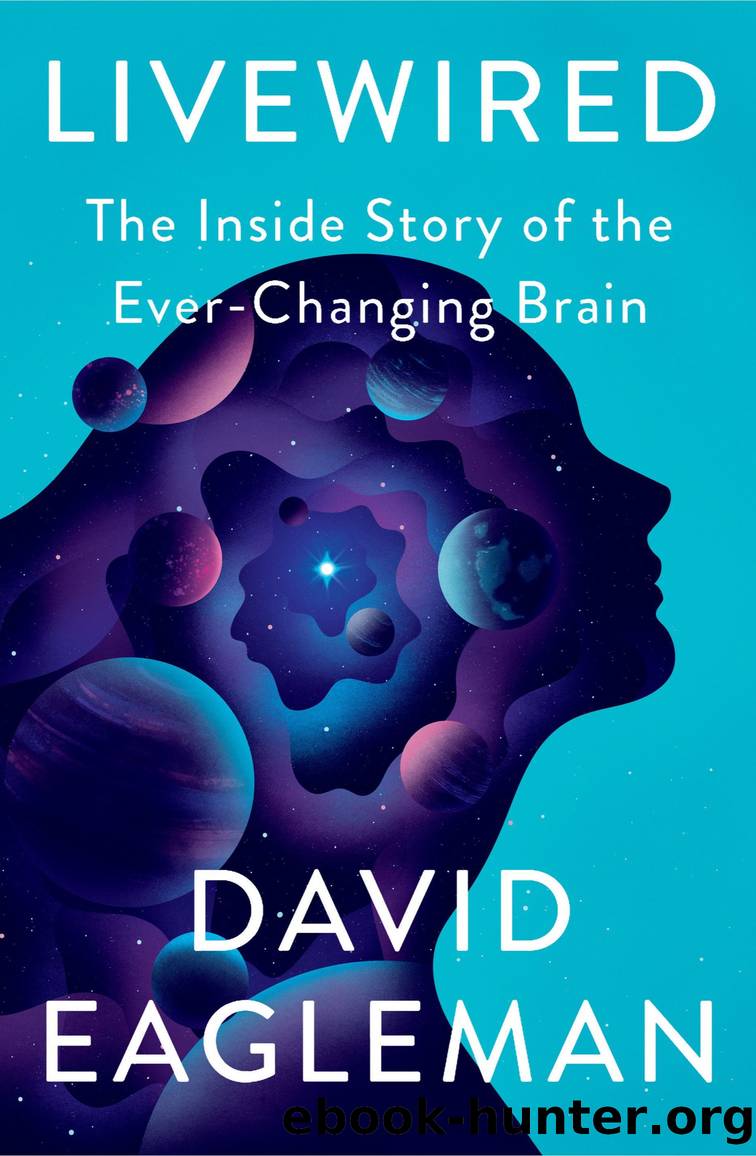Livewired by David Eagleman

Author:David Eagleman [Eagleman, David]
Language: eng
Format: epub
Publisher: Doubleday Canada
Published: 2020-08-25T00:00:00+00:00
THE DIFFERENCE BETWEEN WHAT YOU THOUGHT WOULD HAPPEN AND WHAT ACTUALLY HAPPENED
We’ve been talking about these illusions as results of adaptation, but there’s another way to look at this: as prediction. If you subtract away the downward motion of the waterfall, or the rocking of the boat, or the drawing on your contact lens, this is equivalent to predicting its continued existence. When brain circuitry adjusts, it’s making a guess about what the world is likely to be in the next moment. It stops talking about news that is expected to continue. Think about your retinal blood vessels. They are perceptually invisible because your visual system predicts them away: it knows they are going to be there, so it ignores them. Only if those expectations are violated (as when a light shines in from a strange angle) does your brain spend energy on representing the data.
Your brain doesn’t want to pay the energy cost of spiking neurons, so the goal is to reconfigure the network to waste as little power as possible. If a pattern streams in that is predictable—or even partially guessable—the system saves energy by structuring itself around that input so as not to be surprised by it. A quieter nervous system means fewer violations of expectations: things in the outside world are going approximately as forecast. In other words, an energy-conscious brain wants to predict away everything possible so that it can save its energy for just representing the unexpected. Silence is golden. While many neuroscientists think of activity in neurons as the representation of things in the world, it could turn out that the truth is exactly the opposite: spikes are the unpredicted, energy-expensive part. The representation of something totally expected would be nothing but a hush falling over the neuronal forest.
The system makes adjustments only when it gets surprised. If your brain believes that all bricks weigh the same amount, and then you attempt to pick up a brick made of lead, the violation of your expectation causes cascades of changes to deal with this new turn of events. In contrast, when everything is successfully predicted away, there is no need to change anything. For these reasons, when you first look at the Troxler picture, you notice the blobs, and when you first put in the contact lens, you detect the drawn-on shape. But after a short time your brain adjusts itself. It is no longer surprised.
As another example of the brain predicting things away, consider this. When people first experience the Neosensory wristband (which converts sound to patterns of vibration on the skin), they typically say with surprise, “Whoa, it’s picking up on my own voice!” They are always startled by that: it seems they shouldn’t be registering their own speech. But of course your ears pick up on your voice all the time. It’s typically the loudest voice in your conversations, because your own mouth is the closest one to your ears. However, because you can perfectly predict your own vocalizations, you hardly “hear” your own voice.
Download
This site does not store any files on its server. We only index and link to content provided by other sites. Please contact the content providers to delete copyright contents if any and email us, we'll remove relevant links or contents immediately.
| Administration & Medicine Economics | Allied Health Professions |
| Basic Sciences | Dentistry |
| History | Medical Informatics |
| Medicine | Nursing |
| Pharmacology | Psychology |
| Research | Veterinary Medicine |
When Breath Becomes Air by Paul Kalanithi(7369)
Why We Sleep: Unlocking the Power of Sleep and Dreams by Matthew Walker(5761)
Paper Towns by Green John(4255)
The Immortal Life of Henrietta Lacks by Rebecca Skloot(3895)
The Sports Rules Book by Human Kinetics(3667)
Dynamic Alignment Through Imagery by Eric Franklin(3567)
ACSM's Complete Guide to Fitness & Health by ACSM(3524)
Kaplan MCAT Organic Chemistry Review: Created for MCAT 2015 (Kaplan Test Prep) by Kaplan(3487)
Introduction to Kinesiology by Shirl J. Hoffman(3359)
Livewired by David Eagleman(3207)
The River of Consciousness by Oliver Sacks(3056)
The Death of the Heart by Elizabeth Bowen(2972)
Alchemy and Alchemists by C. J. S. Thompson(2959)
Descartes' Error by Antonio Damasio(2807)
Bad Pharma by Ben Goldacre(2787)
The Gene: An Intimate History by Siddhartha Mukherjee(2557)
Kaplan MCAT Behavioral Sciences Review: Created for MCAT 2015 (Kaplan Test Prep) by Kaplan(2534)
The Fate of Rome: Climate, Disease, and the End of an Empire (The Princeton History of the Ancient World) by Kyle Harper(2511)
The Emperor of All Maladies: A Biography of Cancer by Siddhartha Mukherjee(2509)
